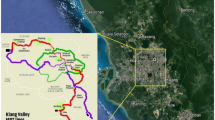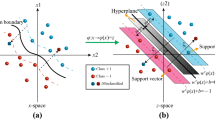Abstract
Piles are widely applied to substructures of various infrastructural buildings. Soil has a complex nature; thus, a variety of empirical models have been proposed for the prediction of the bearing capacity of piles. The aim of this study is to propose a novel artificial intelligent approach to predict vertical load capacity of driven piles in cohesionless soils using support vector regression (SVR) optimized by genetic algorithm (GA). To the best of our knowledge, no research has been developed the GA-SVR model to predict vertical load capacity of driven piles in different timescales as of yet, and the novelty of this study is to develop a new hybrid intelligent approach in this field. To investigate the efficacy of GA-SVR model, two other models, i.e., SVR and linear regression models, are also used for a comparative study. According to the obtained results, GA-SVR model clearly outperformed the SVR and linear regression models by achieving less root mean square error (RMSE) and higher coefficient of determination (R2). In other words, GA-SVR with RMSE of 0.017 and R2 of 0.980 has higher performance than SVR with RMSE of 0.035 and R2 of 0.912, and linear regression model with RMSE of 0.079 and R2 of 0.625.





Similar content being viewed by others
References
Darrag AA (1987) Capacity of driven piles in cohesionless soils including residual stresses. PhD thesis, Purdue Univ., West Lafayette, Ind
Abu Kiefa M (1998) General regression neural networks for driven piles in cohesionless soils. J Geotech Geoenviron Eng 124(12):1177–1185
Meyerhof GG (1976) Bearing capacity and settlement of pile foundations. J Geotech Eng 102(3):196–228
Coyle HM, Castello RR (1981) New design correlations for piles in sand. J Geotech Eng 107(7):965–986
RP2A (1991) Recommended practice for planning, designing and constructing fixed offshore platfonns, 19th edn. American Petroleum Institute, Washington, DC
Randolph MF, Dolwin J, Beck R (1994) Design of driven piles in sand. Geotech Lond 44(3):427–448
Monjezi M, Hasanipanah M, Khandelwal M (2013) Evaluation and prediction of blast-induced ground vibration at Shur River Dam, Iran, by artificial neural network. Neural Comput Appl 22(7–8):1637–1643
Amiri M, Bakhshandeh Amnieh H, Hasanipanah M, Mohammad Khanli L (2016) A new combination of artificial neural network and K-nearest neighbors models to predict blast-induced ground vibration and air-overpressure. Eng Comput 32:631–644
Hasanipanah M, Noorian-Bidgoli M, Armaghani DJ, Khamesi H (2016) Feasibility of PSO-ANN model for predicting surface settlement caused by tunneling. Eng Comput 32(4):705–715
Taheri K, Hasanipanah M, Bagheri Golzar S, Abd Majid MZ (2016) A hybrid artificial bee colony algorithm-artificial neural network for forecasting the blast-produced ground vibration. Eng Comput 33(3):689–700
Armaghani DJ, Hasanipanah M, Mohamad ET (2016) A combination of the ICA-ANN model to predict air-overpressure resulting from blasting. Eng Comput 32(1):155–171
Mohamad ET, Armaghani DJ, Hasanipanah M, Murlidhar BR, Alel MNA (2016) Estimation of air-overpressure produced by blasting operation through a neuro-genetic technique. Environ Earth Sci 75(2):174
Moayedi H, Jahed Armaghani D (2017) Optimizing an ANN model with ICA for estimating bearing capacity of driven pile in cohesionless soil. Eng Comput. https://doi.org/10.1007/s00366-017-0545-7
Samui P (2012) Determination of ultimate capacity of driven piles in cohesionless soil: a multivariate adaptive regression spline approach. Int J Numer Anal Methods Geomech 36:1434–1439
Dzagov AM, Razvodovskii DE (2013) Bearing capacity of driven piles supported on slightly compressible soils. Soil Mech Found Eng 50:187–193
Momeni E, Nazir R, Armaghani DJ, Maizir H (2014) Prediction of pile bearing capacity using a hybrid genetic algorithm-based ANN. Measurement 57:122–131
Das SK, Basudhar PK (2006) Undrained lateral load capacity of piles in clay using artificial neural network. Comput Geotech 33(8):454–459
Shahin MA, Jaksa MB, Maier HR (2001) Artificial neural network applications in geotechnical engineering. Aust Geomech 36(1):49–62
Tarawneh B (2013) Pipe pile setup: database and prediction model using artificial neural network. Soils Found 53(4):607–615
Suman S, Das SK, Mohanty R (2016) Prediction of friction capacity of driven piles in clay using artificial intelligence techniques. Int J Geotech Eng 10(5):1–7
Samui P (2012) Application of relevance vector machine for prediction of ultimate capacity of driven piles in cohesionless soils. Geotech Geol Eng 30(5):1261–1270
Samui P (2011) Prediction of pile bearing capacity using support vector machine. Int J Geotech Eng 5(1):95–102
Muduli PK, Das SK, Das MR (2013) Prediction of lateral load capacity of piles using extreme learning machine. Int J Geotech Eng 7(4):388–394
Samui P (2012) Determination of ultimate capacity of driven piles in cohesionless soil: a multivariate adaptive regression spline approach. Int J Numer Anal Meth Geomech 36(11):1434–1439
Baziar MH, Azizkandi AS, Kashkooli A (2015) Prediction of pile settlement based on cone penetration test results: an ANN approach. KSCE J Civ Eng 19(1):98–106
Moayedi H, Jahed Armaghani D (2018) Optimizing an ANN model with ICA for estimating bearing capacity of driven pile in cohesionless soil. Eng Comput 34:347–356
Moayedi H, Hayati S (2018) Artificial intelligence design charts for predicting friction capacity of driven pile in clay. Neural Comput Appl. https://doi.org/10.1007/s00521-018-3555-5
Shaik S, Rama Krishna KS, Abbas M, Ahmed M, Mavaluru D (2018) Applying several soft computing techniques for prediction of bearing capacity of driven piles. Eng Comput. https://doi.org/10.1007/s00366-018-0674-7
Harandizadeh H, Jahed Armaghani D, Khari M (2019) A new development of ANFIS–GMDH optimized by PSO to predict pile bearing capacity based on experimental datasets. Eng Comput. https://doi.org/10.1007/s00366-019-00849-3
Hasanipanah M, Monjezi M, Shahnazar A, Armaghani DJ, Farazmand A (2015) Feasibility of indirect determination of blast induced ground vibration based on support vector machine. Measurement 75:289–297
Rad HN, Hasanipanah M, Rezaei M, Eghlim AL (2018) Developing a least squares support vector machine for estimating the blast-induced flyrock. Eng Comput 34(4):709–717
Khandelwal M (2011) Blast-induced ground vibration prediction using support vector machine. Eng Comput 27:193–200
Schmidt M (1996) Identifying speaker with support vector networks. In: Interface ‘96 proceedings, Sydney
Li XL, Li LH, Zhang BL, Guo QJ (2013) Hybrid self-adaptive learning based particle swarm optimization and support vector regression model for grade estimation. Neurocomputing 118:179–190
Safarzadegan Gilan S, Bahrami Jovein H, Ramezanianpour AA (2012) Hybrid support vector regression—particle swarm optimization for prediction of compressive strength and RCPT of concretes containing metakaolin. Constr Build Mater 34:321–329
Gunn S (1998) Support vector machines for classification and regression. In: ISIS Technical Report
Vapnik VN, Golowich S, Smola A (1997) Support vector method for function approximation, regression estimation and signal processing. In: Mozer M, Jordan M, Petsche T (eds) Advance in neural information processing system, vol 9. MIT Press, Cambridge, pp 281–287
Hasanipanah M, Shahnazar A, Amnieh HB, Armaghani DJ (2017) Prediction of air-overpressure caused by mine blasting using a new hybrid PSO–SVR model. Eng Comput 33(1):23–31
Chen Y, Tan H (2017) Short-term prediction of electric demand in building sector via hybrid support vector regression. Appl Energy 204:1363–1374
Alade IO, Abd Rahman MA, Saleh TA (2019) Modeling and prediction of the specific heat capacity of Al2O3/water nanofluids using hybrid genetic algorithm/support vector regression model. Nano-Struct Nano-Objects 17:103–111
Jiang L, Diao M, Xue H, Sun H (2018) Energy dissipation prediction for stepped spillway based on genetic algorithm–support vector regression. J Irrig Drain Eng 144:04018003. https://doi.org/10.1061/(ASCE)IR.1943-4774.0001293
Liu S, Tai H, Ding Q, Li D, Xu L, Wei Y (2013) A hybrid approach of support vector regression with genetic algorithm optimization for aquaculture water quality prediction. Math Comput Model 58:458–465
Sajan KS, Kumar V, Tyagi B (2015) Genetic algorithm based support vector machine for on-line voltage stability monitoring. Int J Electr Power Energy Syst 73:200–208. https://doi.org/10.1016/j.ijepes.2015.05.002
Alade IO, Bagudu A, Oyehan TA, Rahman MAA, Saleh TA, Olatunji SO (2018) Estimating the refractive index of oxygenated and deoxygenated hemoglobin using genetic algorithm—support vector machine approach. Comput Methods Programs Biomed. https://doi.org/10.1016/J.CMPB.2018.05.029
Ghaedi M, Dashtian K, Ghaedib AM, Dehghanianc N (2016) A hybrid model of support vector regression with genetic algorithm for forecasting adsorption of malachite green onto multi-walled carbon nanotubes: central composite design optimization. Phys Chem Chem Phys 18:13310–13321
Zhou J, Li X, Shi X (2012) Long-term prediction model of rockburst in underground openings using heuristic algorithms and support vector machines. Saf Sci 50(4):629–644
Zhou J, Li X, Mitri HS (2016) Classification of rockburst in underground projects: comparison of ten supervised learning methods. J Comput Civ Eng 30(5):04016003
Zhou J, Li X, Mitri HS (2018) Evaluation method of rockburst: state-of-the-art literature review. Tunn Undergr Space Technol 81:632–659
Zhou J, Li E, Yang S, Wang M, Shi X, Yao S, Mitri HS (2019) Slope stability prediction for circular mode failure using gradient boosting machine approach based on an updated database of case histories. Saf Sci 118:505–518
Zhou J, Li E, Wang M, Chen X, Shi X, Jiang L (2019) Feasibility of Stochastic Gradient Boosting Approach for Evaluating Seismic Liquefaction Potential Based on SPT and CPT Case Histories. J Perform Constr Facil 33(3):04019024
Zhou J, Li X, Mitri HS (2015) Comparative performance of six supervised learning methods for the development of models of hard rock pillar stability prediction. Nat Hazards 79(1):291–316
Zhou J, Shi X, Du K, Qiu X, Li X, Mitri HS (2017) Feasibility of random-forest approach for prediction of ground settlements induced by the construction of a shield-driven tunnel. Int J Geomech 17(6):04016129
Zhou J, Shi X, Li X (2016) Utilizing gradient boosted machine for the prediction of damage to residential structures owing to blasting vibrations of open pit mining. J Vib Control 22(19):3986–3997
Yang HQ, Lan YF, Lu L, Zhou XP (2015) A quasi-three-dimensional spring- deformable-block model for runout analysis of rapid landslide motion. Eng Geol 185:20–32
Yang HQ, Zeng YY, Lan YF, Zhou XP (2014) analysis of the excavation damaged zone around a tunnel accounting for geostress and unloading. Int J Rock Mech Min 69:59–66
Yang H, Hasanipanah M, Tahir MM, Bui DT (2019) Intelligent prediction of blasting-induced ground vibration using ANFIS optimized by GA and PSO. Nat Resour Res. https://doi.org/10.1007/s11053-019-09515-3
Author information
Authors and Affiliations
Corresponding authors
Additional information
Publisher's Note
Springer Nature remains neutral with regard to jurisdictional claims in published maps and institutional affiliations.
Rights and permissions
About this article
Cite this article
Luo, Z., Hasanipanah, M., Bakhshandeh Amnieh, H. et al. GA-SVR: a novel hybrid data-driven model to simulate vertical load capacity of driven piles. Engineering with Computers 37, 823–831 (2021). https://doi.org/10.1007/s00366-019-00858-2
Received:
Accepted:
Published:
Issue Date:
DOI: https://doi.org/10.1007/s00366-019-00858-2




